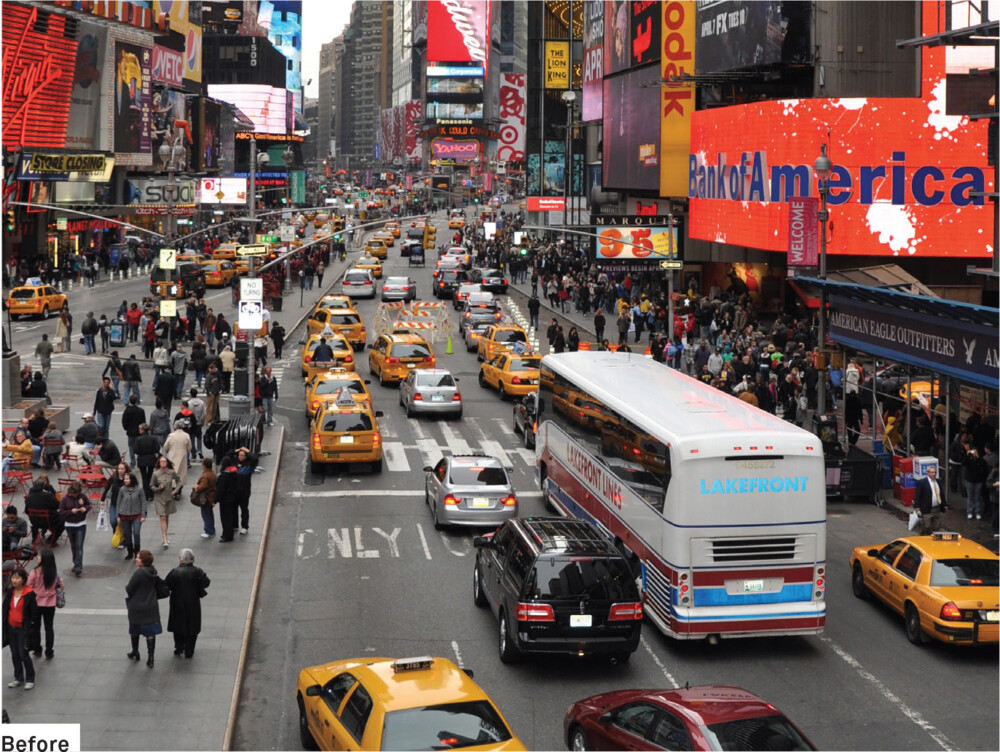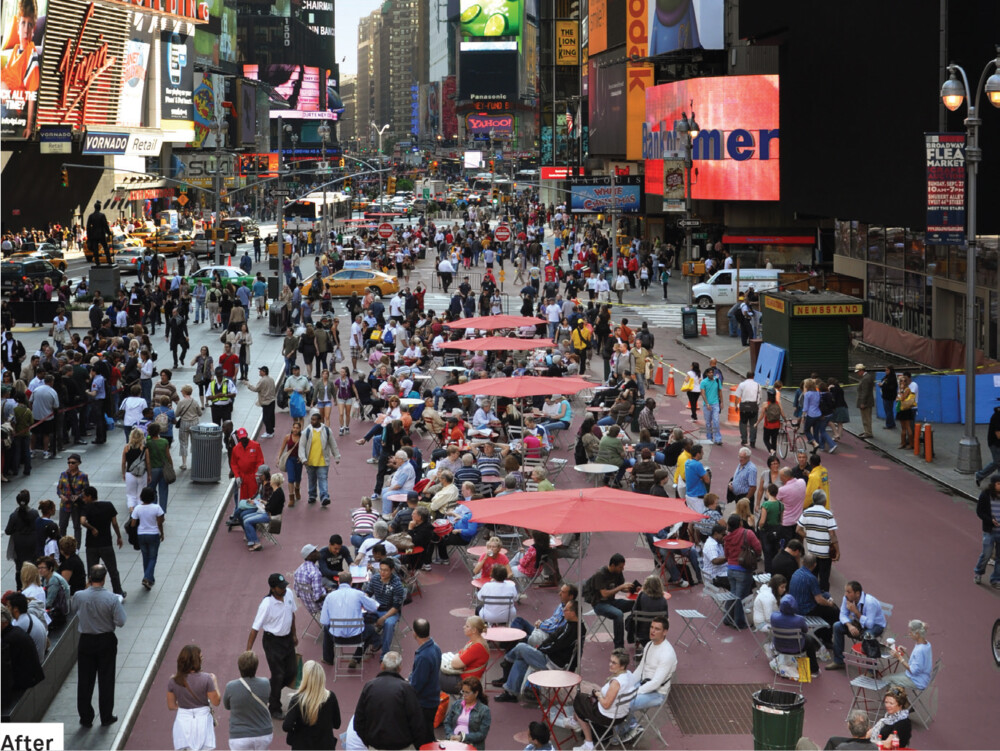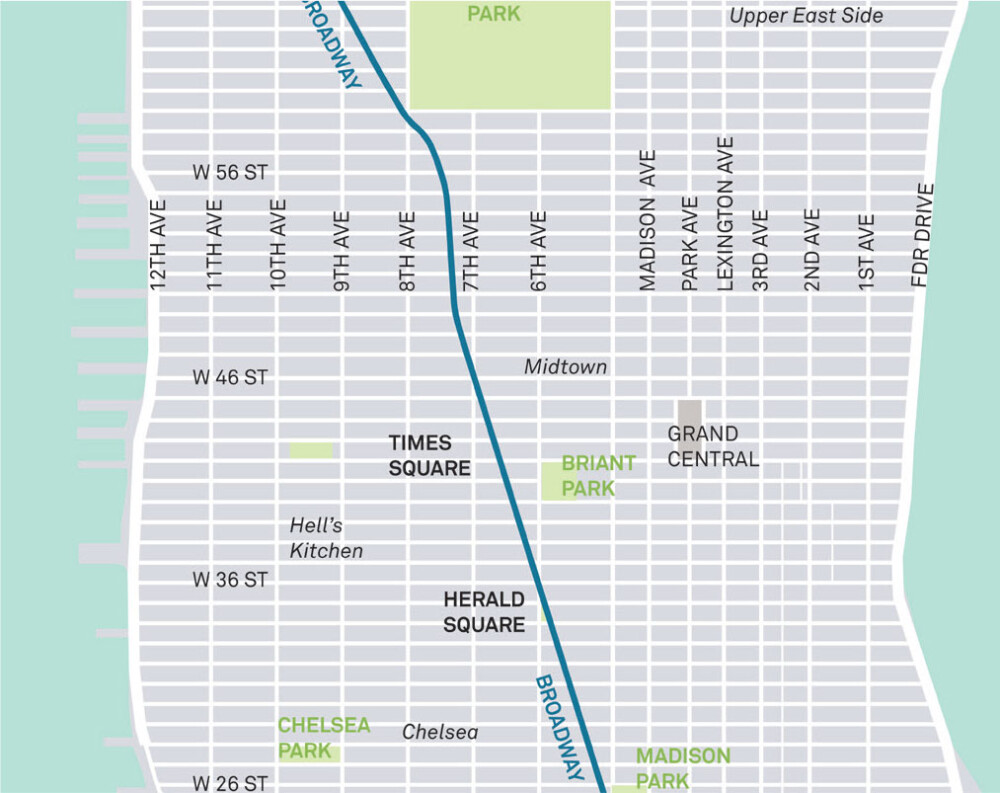-
About Streets
- Introduction
- Defining Streets
-
Shaping Streets
- The Process of Shaping Streets
- Aligning with City and Regional Agendas
- Involving the Right Stakeholders
- Setting a Project Vision
- Communication and Engagement
- Costs and Budgets
- Phasing and Interim Strategies
- Coordination and Project Management
- Implementation and Materials
- Management
- Maintenance
- Institutionalizing Change
- Measuring and Evaluating Streets
-
Street Design Guidance
- Designing Streets for Great Cities
- Designing Streets for Place
-
Designing Streets for People
- Utilities and Infrastructure
- Operational and Management Strategies
- Design Controls
-
Street Transformations
- Streets
-
Intersections
- Intersection Design Strategies
- Intersection Analysis
- Intersection Redesign
- Mini Roundabout
- Small Raised Intersection
- Neighborhood Gateway Intersection
- Intersection of Two-Way and One-Way Streets
- Major Intersection: Reclaiming the Corners
- Major Intersection: Squaring the Circle
- Major Intersection: Cycle Protection
- Complex Intersection: Adding Public Plazas
- Complex Intersection: Improving Traffic Circles
- Complex Intersection: Increasing Permeability
- Resources
Global Street Design Guide
-
About Streets
- Introduction
- Defining Streets
-
Shaping Streets
Back Shaping Streets
- The Process of Shaping Streets
- Aligning with City and Regional Agendas
- Involving the Right Stakeholders
- Setting a Project Vision
- Communication and Engagement
- Costs and Budgets
- Phasing and Interim Strategies
- Coordination and Project Management
- Implementation and Materials
- Management
- Maintenance
- Institutionalizing Change
-
Measuring and Evaluating Streets
Back Measuring and Evaluating Streets
-
Street Design Guidance
-
Designing Streets for Great Cities
Back Designing Streets for Great Cities
-
Designing Streets for Place
Back Designing Streets for Place
-
Designing Streets for People
Back Designing Streets for People
- Comparing Street Users
- A Variety of Street Users
-
Designing for Pedestrians
Back Designing for Pedestrians
- Designing for Cyclists
-
Designing for Transit Riders
Back Designing for Transit Riders
- Overview
- Transit Networks
- Transit Toolbox
-
Transit Facilities
Back Transit Facilities
-
Transit Stops
Back Transit Stops
-
Additional Guidance
Back Additional Guidance
-
Designing for Motorists
Back Designing for Motorists
-
Designing for Freight and Service Operators
Back Designing for Freight and Service Operators
-
Designing for People Doing Business
Back Designing for People Doing Business
-
Utilities and Infrastructure
Back Utilities and Infrastructure
- Utilities
-
Green Infrastructure and Stormwater Management
Back Green Infrastructure and Stormwater Management
-
Lighting and Technology
Back Lighting and Technology
-
Operational and Management Strategies
Back Operational and Management Strategies
- Design Controls
-
Street Transformations
-
Streets
Back Streets
- Street Design Strategies
- Street Typologies
-
Pedestrian-Priority Spaces
Back Pedestrian-Priority Spaces
-
Pedestrian-Only Streets
Back Pedestrian-Only Streets
-
Laneways and Alleys
Back Laneways and Alleys
- Parklets
-
Pedestrian Plazas
Back Pedestrian Plazas
-
Pedestrian-Only Streets
-
Shared Streets
Back Shared Streets
-
Commercial Shared Streets
Back Commercial Shared Streets
-
Residential Shared Streets
Back Residential Shared Streets
-
Commercial Shared Streets
-
Neighborhood Streets
Back Neighborhood Streets
-
Residential Streets
Back Residential Streets
-
Neighborhood Main Streets
Back Neighborhood Main Streets
-
Residential Streets
-
Avenues and Boulevards
Back Avenues and Boulevards
-
Central One-Way Streets
Back Central One-Way Streets
-
Central Two-Way Streets
Back Central Two-Way Streets
- Transit Streets
-
Large Streets with Transit
Back Large Streets with Transit
- Grand Streets
-
Central One-Way Streets
-
Special Conditions
Back Special Conditions
-
Elevated Structure Improvement
Back Elevated Structure Improvement
-
Elevated Structure Removal
Back Elevated Structure Removal
-
Streets to Streams
Back Streets to Streams
-
Temporary Street Closures
Back Temporary Street Closures
-
Post-Industrial Revitalization
Back Post-Industrial Revitalization
-
Waterfront and Parkside Streets
Back Waterfront and Parkside Streets
-
Historic Streets
Back Historic Streets
-
Elevated Structure Improvement
-
Streets in Informal Areas
Back Streets in Informal Areas
-
Intersections
Back Intersections
- Intersection Design Strategies
- Intersection Analysis
- Intersection Redesign
- Mini Roundabout
- Small Raised Intersection
- Neighborhood Gateway Intersection
- Intersection of Two-Way and One-Way Streets
- Major Intersection: Reclaiming the Corners
- Major Intersection: Squaring the Circle
- Major Intersection: Cycle Protection
- Complex Intersection: Adding Public Plazas
- Complex Intersection: Improving Traffic Circles
- Complex Intersection: Increasing Permeability
- Resources
- Guides & Publications
- Global Street Design Guide
- Streets
- Pedestrian-Priority Spaces
- Pedestrian Plazas
- Case Study: Plaza Program; New York City, USA
Case Study: Plaza Program; New York City, USA

Location: New York City, USA
Population: 8.4 million
Metro: 20 million
Extent: Citywide
Right-of-Way: Varies
Context: Mixed-use (Residential/Commercial)
Funding: Public and private
Overview
The Plaza Program is a citywide effort led by the Department of Transportation (DOT) of New York City to create cost-effective, high-quality public spaces in underutilized roadways throughout the city.
The program aims to prioritize areas that currently lack open space, especially in high-pedestrian or low-income neighborhoods.
Plazas have been proven to enhance local economic vitality, pedestrian mobility, access to public transit, and safety.
NYC DOT partners with nonprofit applicants to develop plazas that meet the needs of local communities. It works with local groups to manage ongoing maintenance.
There are 71 plazas citywide in some phase of planning, design, construction, or completion, with 49 open to the public as of 2015.


Key Elements
Visually enhanced pedestrian space, maximizing comfort and active uses.
Furniture, generally movable seating and tables for maximum flexibility.
Extended areas for open-air activities.
Goals
- Create a pedestrian destination.
- Improve walkability.
- Improve access to transit.
- Enhance vehicular and pedestrian safety.
- Support local development and build community partnerships.
- Preserve and promote neighborhood character
Lessons Learned
The Plaza Program is a cost-effective measure to provides amenities that support social gathering, increase a sense of place, and enhance pedestrian movement and safety.
The program builds support for changes through temporary surface treatments, utilizing interim changes to collect data to support permanent change.
Facilitating new public space through an application process allows communities to ask for plazas in their neighborhoods.
Involvement
NYC Department of Transportation (DOT), Department of City Planning, Department of Design and Construction, private partnerships, citizen associations, advocacy
groups, and Business Improvement Districts.

Pearl Street, New York. Underutilized spaces used for parking.

Pearl Street, New York. Plaza activated with seating and planting.
Green Light for Midtown
Green Light for Midtown is a major initiative to improve mobility and safety on the Broadway corridor, in Midtown Manhattan. The project created new pedestrian plazas in the Times Square and Herald Square areas, along with safety improvements along the Broadway corridor between Columbus Circle and Madison Square. The Department of Transportation collected extensive data in the months just prior to and just following project implementation, highlighting the impacts of these measures.
Project Timeline of Green Light for Midtown
2009–2015 (Approximately 6 Years)

Evaluation of Green Light for Midtown

Adapted by Global Street Design Guide published by Island Press.